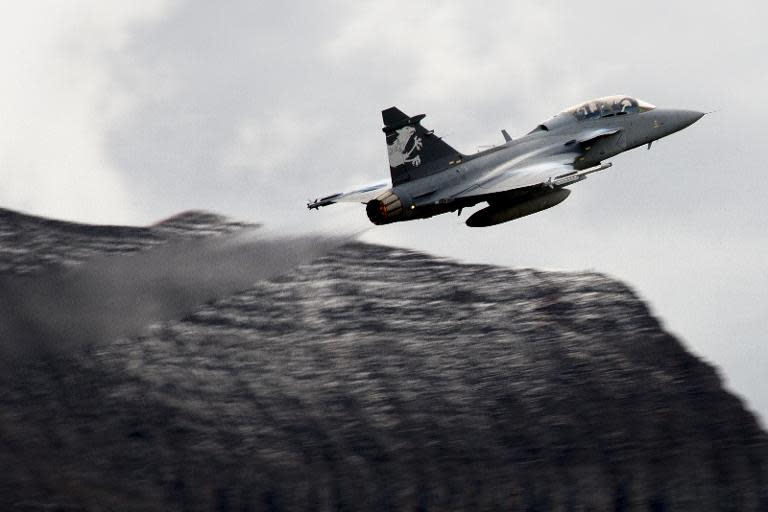Brazil Snubs Boeing in Fighter Jet Deal
By DAN HORCH and CHRISTOPHER DREW Published: December 18, 2013
SÃO PAULO, Brazil — In a disappointment for Boeing, Brazilian defense officials said on Wednesday that they had picked the aircraft maker Saab for a $4.5 billion contract to build 36 fighter jets over the next 10 years.
The Brazilian defense minister, Celso Amorim, told reporters at a news conference in Brasilia that Saab was selected over Boeing because it had agreed to share more technology with contractors and because many parts for the new jet, the Gripen NG, would be made in Brazil.
The decision “took into account performance, the effective transfer of technology and costs, not only of acquisition, but also of maintenance,” Mr. Amorim said in a statement. He was accompanied by Gen. Juniti Saito, the Brazilian air force’s chief of staff. “The decision was based on these three factors.”
The announcement comes at a time of heightened tension between the United States and Brazil. In September, the Brazilian president, Dilma Rousseff, canceled a state visit to the United States after revelations that the National Security Agency was spying on foreign heads of state, including her.
In a speech at the United Nations that month, Ms. Rousseff gave a blistering attack on the United States for its “illegal interception of information and data.”
In a response to the outcry over the spying, a panel of advisers for President Obama on Wednesday recommended limiting the wide-ranging collection of personal data and restricting operations to spy on foreign leaders.
When asked at the news conference if the spying had anything to do with the decision to award the contract to Saab, Mr. Amorim did not answer directly, instead repeating reasons of cost and technology sharing.
Analysts said Brazil had many financial and practical reasons to award the contract to Saab.
Richard L. Aboulafia, an aviation analyst at Teal Group in Fairfax, Va., said that while Brazil’s disenchantment over the N.S.A.’s spying could have played a role in the decision, costs were probably a bigger factor.
“You’re talking about a military service that doesn’t need a heavyweight front-line fighter and has suffered a budget squeeze and hasn’t been able to fly the planes that it owns,” he said.
He added that a basic version of the Saab jet might cost about $45 million, compared with $55 million for Boeing’s basic F/A-18 Super Hornet.
And the Gripen’s fuel costs would be half of that for the Boeing plane. Both jets use the same engine, but the Super Hornet has two engines and the Gripen one.
A study by the military publisher IHS Jane’s said that the Gripen costs about $4,700 an hour to fly — the lowest among modern fighter jets — compared with the $11,000 for the Super Hornet.
Boeing said that the decision was “disappointing” and that it would talk to the Brazilian air force to better understand it. The company, based in Chicago, said it would still look for chances to expand its partnerships in Brazil.
The loss was also difficult for Boeing because there are only a few fighter competitions going on around the world and the United States Navy plans to stop buying the F/A-18’s.
While most countries that want high-tech fighters are buying Lockheed Martin’s more advanced F-35, many other countries cannot afford even top older models like the F/A-18. So far, Australia is Boeing’s only export customer for the jet.
By contrast, Saab’s more workaday Gripen models are flown by several other countries.
Brazil originally began its quest for new fighters to replace its aging Mirages more than a decade ago. Brazil’s former president, Luiz Inácio Lula da Silva, wanted to buy Dassault’s Rafale fighter jets in 2009 instead of the F/A-18.
But a change in administration in Brazil, and the country’s deteriorating financial condition, helped alter the equation. A Brazilian news report on Saturday said that Dassault had already been eliminated from the competition even though the French president, François Hollande, backed the jet on a visit to Brazil last week.
Terms of the deal must still be negotiated over the next year, but delivery of the first batch of Gripen NG jets is expected in 2018.
Also on Wednesday, Boeing announced the promotion of Dennis A. Muilenburg, the head of its military business, to vice chairman, president and chief operating officer of the company. Analysts said that move made Mr. Muilenburg, 49, the heir apparent to Boeing’s chief executive, W. James McNerney Jr., who is 64.
Ray Conner, the chief executive of Boeing’s commercial airplane division, was also named a Boeing vice chairman while keeping his current responsibilities. Christopher M. Chadwick, 53, will succeed Mr. Muilenburg as chief executive of Boeing’s military unit.



